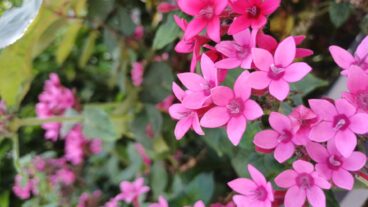Yoga enthusiasts participate in a lesson at the Mayoga Center in Kfar Saba.It seems a bit incongruous: the non-stop hustle bustle of life in Israel and the calm serenity of yoga. But during the last few years the two have found a way to coexist in harmony and in the process Israelis are becoming less stressed.
Israel isn’t a den of Zen just yet but there’s always hope. Yoga is catching on with increasing popularity as exemplified by the opening last month of the country’s largest yoga center in Kfar Saba.
The Mayoga Center, a spacious glass-front building with panoramic views overlooking the green vista of a soon-to-open municipal park, is the pet project of David and Miri Iny who only recently latched onto ancient India-derived system of physical and mental practice.
“After the untimely death of a family member five years ago we sought a way to achieve equilibrium so we took up yoga,” Miri, the center’s administrative director told ISRAEL21c at the festive launch. “Two years later we began traveling to India for study sessions. As I was on sabbatical that year from teaching, I took a yoga teaching course when I returned.”
Iny had previously spent 30 challenging years in Israel’s school system as a gym teacher and then school principal. But through yoga she began noticing changes in her life that continue to influence.
“The main change is in the calm and tranquility I now enjoy. I don’t run around so much any more. I have time for everything. In the past I was more demanding of myself and others but now I’m quite different,” she said.
Her yen for yoga is shared not only by her husband, the center’s business advisor, but by three of their four children, including one who teaches yoga in New York.
But the Inys are not the only Israeli yoga enthusiasts. A brief scan of the web portal yoga.co.il lists hundreds of teachers and courses in Israel and those ‘in the know’ estimate there are more than 100,000 practitioners and 2,000 teachers in the country.
Yoga comes from a Sanskrit word meaning unity and some of its features originated over 5,000 years ago among the ascetics of southern India. Yoga postures or asanas evolved through observation of graceful animal movements and have endured. After 1500 BCE, yoga gradually developed alongside Hinduism.
Until the 20th century all yogis were Hindu priests and yoga experts began traveling West. Yogi Vivekananda was the first to arrive in the US on a lecture tour in 1893 and there yoga’s mystical and spiritual focus changed to a more pragmatic package of exercises and breath control as yoga schools sprouted up after World War II.
In the 1950’s yoga entered the sports world when Selvarajan Yesudian wrote the international bestseller Sports and Yoga. In the 1960s Hatha yoga was successfully marketed in America by Richard Hittleman and in Britain The Beatles’ flamboyant flirtation with Yogi Maharishi Mahesh and TM (transcendental meditation) hit the headlines in 1968.
Fervor aside, the Western approach to yoga remains largely secular and focused on healthful exercises aimed at toning the body. Contemplation and meditation remain integral parts of any yoga practice but relaxation is key.
Israel’s first Prime Minister David Ben Gurion was known for his yoga prowess and he was often photographed standing on his head. His guru Moshe Feldenkreis (1904-1984) was famous in his own right as founder of the Feldenkreis method. Rachel Solberg, who studied under two prominent Indian gurus was Israel’s yoga pioneer and she founded the Israeli Yoga Teachers Association in 1979. Solberg teaches to this day.
One can broadly divide today’s yoga practitioners into hobbyists and devotees. Hobbyists benefit from the yoga experience without plumbing its depths. 35-year-old graphic designer Elisheva Sultan is a hobbyist who finds exposure to yoga pleasing.
“After working up a sweat in an energetic step or aerobic class, I found the low intensity and slower pace a welcome contrast,” she said “Sometimes I went directly to yoga after a hard day’s work. It was a relaxing, enjoyable type of movement and gave me peace of mind.”
31-year-old Chilean born classical musician Macarena Lopez practiced Ashtanga yoga for a year and grew to love it. “It gave me a great workout. I felt more energized and after approximately eight months I noticed a change in my body. I felt and looked leaner and had more flexibility. I highly recommend it but if you’re a beginner you have to be really patient. It’s quite tough but in the end it’s worth it. You feel lighter and stronger.”
Translator Zipi Jacobson began yoga in her 50s and found it difficult at first. “I used to tell the teacher, ‘I can’t do it – it hurts,’ and she’d reply, ‘No such thing as can’t. Breathe into the pain!’ That taught me pain control and how to relax and stretch stiff muscles without straining. Besides this increased mobility, my breathing improved. No longer a mouth breather, I notice an increase in lung capacity.”
At the opening of the Mayoga Center, the crowd gathered for cocktails and canapes, clustering around a bald yogi on a mat and marveling as he folded his legs neatly over his shoulders and smoothly contorted rubber limbs.
The center, with its three spacious 100-square meter halls and 7 treatment rooms is tastefully decorated in soothing pastel shades. Thirty different types of yoga are available to students and meditation, Pilates and teacher training programs are also offered.
Eini’s target market is the upscale population of Kfar Saba and its satellite communities. She aims to attract people of all ages: babies and children, pregnant and post-partum women, high tech techies working nearby and retirees. Family activities will offer the wider community their first exposure to yoga while singles can relax and socialize in the health bar and spacious cafeteria after a strenuous workout.
Devotees of yoga, however, live, think and breathe yoga and a trip or two to India is usually a must. Defense Minister Ehud Barak spent a month in an ashram in India before returning to politics last year, and the country has been a prime destination of post-army travelers for years.
According to veteran teacher Ronit Aizenberg, director of the yoga studies program at Reidman College of Complimentary Medicine, yoga is often part of the curriculum in schools and preschools in Israel in an effort to counteract violent and aggressive tendencies in the young. Although there is generally marked improvement Aizenberg cautions not to expect instant results. “Yoga doesn’t work that way,” she says, “It takes time, effort and patience.”
Aizenberg, who organized nationwide yoga conferences in 2004 and 2005 attended by over 2,000 people, described a novel parent-child program she runs with two associates at the Mayoga Center. Parents work out for an hour and a half, while children have a separate 45 minute class followed by activity sessions. They are exposed to shiatsu, reflexology, nutrition awareness and experiment with traditional percussion instruments. Sometimes they make mandalas – colorful symbols from Indian-Tibetan culture. Every two months there is a combined yoga session for parent and child. “Parents get to spend quality time with their children,” Aizenberg remarks.
She views yoga as the key to physical and emotional health and a beneficial force that, if practiced over a long period of time, can improve social interactions and mellow personality traits.
Niv Dor-Cohen, another expert on Israel’s yoga scene, advises trying to retain the tranquility one achieves in a workout. “When the practice of yoga continues on and flows into your life it’s a potent tool for positive change.”
Increasing numbers of Israelis are taking that advice to heart and slowing the daily life hustle and bustle to help make things a little more relaxing.![]()












